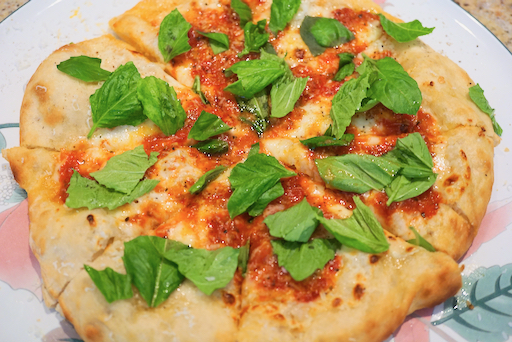Compared to the pizza stone, the steel retains and conducts heat better. When making multiple pizzas, the pizza stone requires a few minutes to recover and reach the correct heat settings after making each pizza. The pizza steel appears to stay hot. The bottom of the crust gets carbonized a bit too much, though. I only used the pizza steel once. I have to try a few more time before I can evaluate properly. I am sticking to the pizza stone for now.
In any case, picture #1A is my most recent pizza (using “00” flour, half Margherita and half pepperoni). To me, the crust charr marks are just right (“Darkness” setting at 11 o’clock) as compared to #3 which was too charred with the “Darkness” setting at one o’clock.
The next pizza (picture #1B) is our first attempt using pesto (from the basil on home-grown on the window sill) and red pepper sauce. The cheeses are low moisture Mozzarella and fresh goat cheese.
The picture #2 is another Margherita I made earlier. It looks “charred” but the taste was not bad, it did not taste like you are eating pure carbon but it was too much charr. This was the “darkness” setting at one o’clock.
Picture #3 is one of our most popular pizza; artichoke hearts (from a jar) with olives. Cheeses are mozzarella, Irish cheddar, smoked gouda and fresh goat cheese. This was baked immediately after the #3 pizza (I prepared this pizza in a wooden pizza paddle while the first one was being cooked). This made this pizza crust bottom not as crispy and charred since the pizza stone was not completely recovered heat.
Although this is still on-going process, the below are my current set-ups for the oven and dough.
Dough: I tried both “00” and bread flours with and without addition of olive oil. “00” dough without olive oil is a bit too chewy for us but addition of a small amount of olive oil appears to make it better (may not be authentic for Neapolitan or New York pizza). For us, the bread flour or “00” flour does not make a big difference but we may even prefer “bread-y” consistency of crust using the bread flour.
Ingredients:
3 and 1/2 of flour (either bread or “00”)
2 tbs olive oil
1 (or a bit more) cup of water
2 tsp Kosher salt
2 tsp instant yeast
Directions: (I use the food processor fitted with a kneading blade in low-speed up to 4 cups of flour).
After running the blade to mix all the dry ingredients, I drizzle the water in a thin steady stream as it is running until the dough forms above the blade (the surface is a bit sticky). Let it sit for 5 minutes for better hydration and run another 1-2 minutes. Take it out on a floured board and hand knead until elastic. Placed the dough in a lightly oiled bowl, turn it over to coat all the surface, cover it with a plastic wrap and place it in a proofing box at 85F for 1 hour or until doubles.
Deflate gently, fold several times and divide it up into 4 equal dough balls (I weigh making 4 balls of a bit over 200grams each). After the first rise, I divide the dough and form 4 balls with a smooth surface. Place it in a small Ziploc bag coated with olive oil inside and let it sit in the refrigerator at least overnight or up to several days. I take out the dough balls one hour before baking and let it come to the room temperature. If I do not use it within several days, I freeze them. (to use the frozen dough, I transfer it to the refrigerator one day before to completely thaw).
I hand stretch the dough to make 10 inch pizza, coat it with olive oil with crushed garlic. I place the slices of low moisture Mozzarella first and then tomato sauce.
Oven settings: “Wood fired” and the darkness setting to “11 o’clock”. Preheat for 30 minutes. I use the modified the wooden paddles which fit the oven perfectly. I use corn meal on the paddle so that the dough slides better. I cook for 2 minutes (as it is the automatically setting). Steam and some smoke come out during cooking so I use the oven under the hood with the exhaust fan running. For the next pizza, I wait until the stone temperature completely recovers (a few minutes until the “at temp” indicator light stops blinking).
Is it worth it?? Although pizza I made using the regular oven and pizza stone was quite good, pizza cooked in the Pizzaiola is definitely much better. They cook so quickly (instead of 6-7 minutes in the conventional oven they’re done in just 2 minutes). So if you have a pizza party, you could turn out a few pizzas in a jiffy. I am trying to keep this oven clean but it is a bit of a chore. Other use of this oven may be to bake focaccia (which we tried with a good result) or naan (which we have not tried yet).






























.jpeg)













